Complete Guide to Richmond National Battlefield Park in Virginia including things to see, Civil War Battlefields, directions, and so much more.
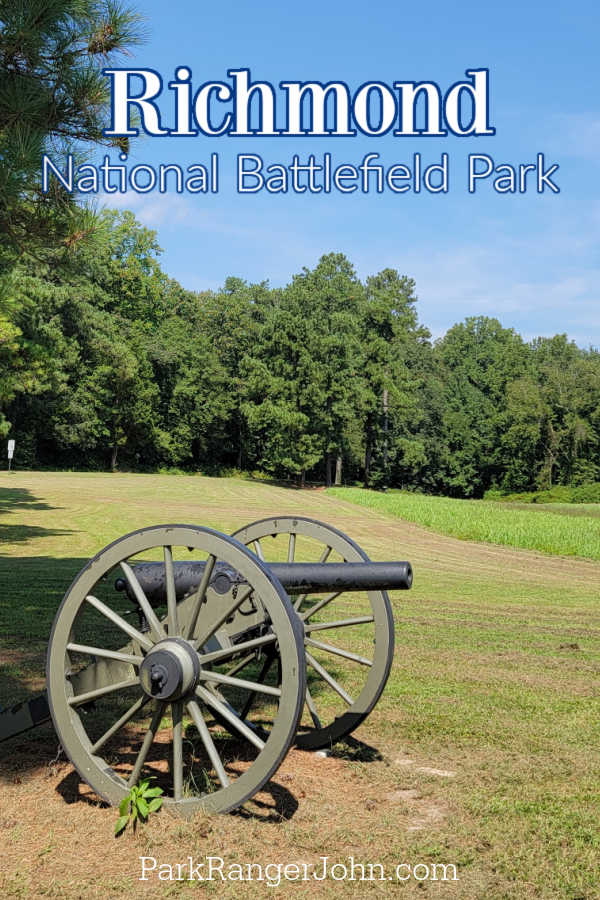
Richmond National Battlefield Park
Richmond National Battlefield Park includes 13 park units scattered across Hanover, Henrico, and Chesterfield counties and the city of Richmond.
About Richmond National Battlefield Park
Richmond, Virginia was the industrial and political capital of the Confederacy during the Civil War.
Often at the heart of the conflict, the city of Richmond, Virginia was heavily contended over the span of four bloody years. From 1861-1865, the Civil War was fought around the city, and sometimes in the center of it.
Today, the Richmond National Battlefield Park preserves thirteen important historical sites from the Civil War era.
From hiking trails following in the footsteps of soldiers to preserved fortifications and so much more, this national park presents a fascinating look at one of the country’s most important historical events.
Below you’ll find the ultimate guide to Richmond National Battlefield Park.
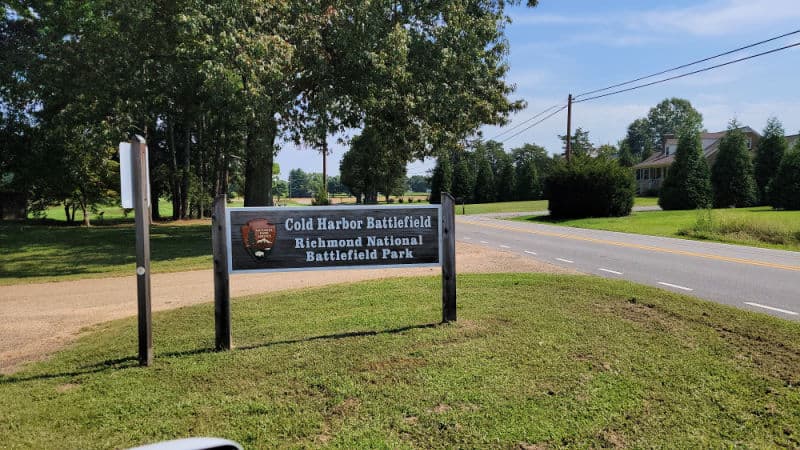
Is Richmond National Battlefield Park worth visiting?
The short answer: Yes! Richmond National Battlefield Park is especially great for history buffs, but even if you go into it not caring much for the subject, you’re sure to leave at least a little bit wiser on the subject of the Civil War.
The park is spread across 13 different sites, some of which are in the heart of Richmond, which makes it easily accessible even if you’re short on time.
History of Richmond National Battlefield Park
The Richmond National Battlefield Park preserves thirteen historical sites from the Civil War. Richmond historically was the capital of the Confederacy.
And as such was important to both the Confederates and the Union. Because it was the hub of the Confederacy, many battles raged in the areas around the city.
Richmond became the Confederate capital because it was a manufacturing and transportation hub with the Tredegar Iron Works and the joining of 5 railroads.
This railroad confluence also meant that Richmond became the center for healthcare for the Confederacy, with the construction of the Chimborazo Hospital camp.
The Union made many attempts to take control of the city. The first attempt was in 1862 during the Peninsula Campaign, headed by Union Maj. Gen. George B. McClellan.
In the end, it was Union General Ulysses S. Grant who succeeded in taking the Confederate Capital, defeating Confederate Gen. Robert E. Lee during the Siege of Petersburg.
Rather than have their supplies and factories fall into Union hands, the Confederates burnt them while evacuating the city. The fire destroyed much of the center of Richmond.
Peninsula Campaign
The Peninsula Campaign was the Union's first attempt to capture Richmond. During the campaign, Gen. McClellan maneuvered the Army of the Potomac across Virginia. He planned to move the army through the York and James River Peninsula to Richmond.
McClellan was overly cautious and believed the Confederates had far greater numbers than they did. Because of this, he was very hesitant to engage them or advance toward the capital. He did so, however, reluctantly in late May 1862.
The Confederates were under the leadership of Gen. Joseph E. Johnston during the campaign, who was just as cautious as his Union counterpart.
As McClellan moved up the Peninsula towards Richmond, he met resistance from the Confederates along the Warwick Line. However, the Confederates knew their best chance was to withdraw and secure Richmond.
McClellan tried and failed to cut off the Confederate retreat, as did the U.S Navy's attempt to take Richmond by moving up the James River.
The Peninsula campaign culminated with two major battles, The Battle of Seven Pines and the Seven Days Battles.
The Battle of Seven Pines
Due to the cautious nature of McClellan, he missed an opportunity to cut the Confederates off at Yorktown in April 1862. He planned to siege the city of Yorktown and made the necessary arrangements.
In May, while McClellan was moving heavy equipment around the town to strengthen the siege, the Confederates slipped out and retreated to Richmond.
With the Confederate retreat, the Union General had no choice but to move his forces up to the outskirts of Richmond.
Confederate forces had prepared for the arrival of the Union. Their defensive line included Drewry's Bluff, the James River, and the swampy terrain of the Chickahominy River. Several of the bridges over the Chickahominy River were also destroyed.
On the 31st of May, the Confederates attacked, beginning the two-day battle. Johnston wanted to overwhelm the Union divisions South of the Chickahominy and push the Union back.
They succeeded, but the Union army was reinforced, making it possible to hold the line. Johnston was wounded during the fight and replaced by Gen. Robert E. Lee.
The Seven Days Battles
The Battle of Seven Pines was over on the 1st of June, with both sides claiming victory. Strategically, the battle had achieved little, other than both sides suffering high losses.
For the remainder of June, the new commanding General of the Confederates, Robert E. Lee, prepared a counter-attack.
Lee was far more aggressive in his approach than Johnston. Lee planned to attack the Union forces who remained camped across the Chickahominy. He wanted to drive the Union back away from Richmond to secure the capital.
On the 25th of June, McClellan had guessed that Lee was about to attack. McClellan instead attacked the Confederates who were defending Richmond at Oak Grove. He stopped the fight as the night fell.
Stopping the Union attack was a move that cost McClellan his chance at securing Richmond.
The next day Lee put his plan into motion. In what would become known as the Seven Days Battles, Lee relentlessly attacked the Union forces for seven days.
The battles took place in Mechanicsville, Gaines’s Mill, Garnett’s and Goldberg's Farm, Savage’s Station, White Oak Swamp, and Malvern Hill.
In the end, Gen. Robert E. Lee successfully pushed the Union army back from Richmond. The Union would not have another opportunity to take Richmond until 1864.
The Siege of Petersburg and the Fall of Richmond
In June 1864, another Union general made it his mission to take control of the Confederate capital, General Ulysses S. Grant. Unable to defeat Lee in open warfare and take Richmond that way, Grant changed his tactics.
Grant wanted to cut off the Confederate supply lines to and from Richmond. Capturing Petersburg, 24 miles south of Richmond, could achieve this.
For nine months, the Confederate and Union armies engaged in trench warfare. These trenches stretched from Petersburg to the outskirts of Richmond.
The Union matched every attack made against the Confederates at Petersburg, at Richmond.
After nine months, Lee knew he could no longer hold Petersburg. The starving Confederates evacuated Petersburg and Richmond on the 2nd of April, burning their supplies and factories as they went.
The fall of Richmond to the Union was a blow that the Confederacy could not recover from, and the Civil War concluded sixteen months later.
Much of what can be seen today at the Richmond National Battlefield Park is as it would have been during the Civil War. Here at Richmond, two of the most famous generals went head-to-head to control the heart of the Confederacy.
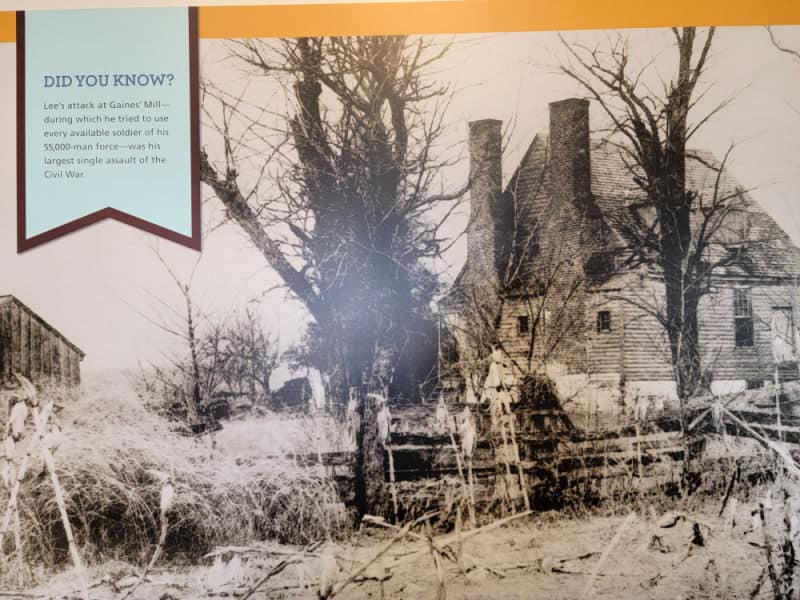
Things to know before your visit to Richmond National Battlefield Park
Entrance fee
$0.00, There is no charge to visit the park
The parking lot at Tredegar Iron Works charges a nominal parking fee, and limited free public parking is available nearby.
Learn more about National Park Passes for parks that have an entrance fee.
$80.00 - For the America the Beautiful/National Park Pass. The pass covers entrance fees to all US National Park Sites and over 2,000 Federal Recreation Fee Sites for an entire year and covers everyone in the car for per-vehicle sites and up to 4 adults for per-person sites.

Buy your pass at this link, and REI will donate 10% of pass proceeds to the National Forest Foundation, National Park Foundation, and the U.S. Endowment for Forestry & Communities.
National Park Free Entrance Days -Mark your calendars with the five free entrance days the National Park Service offers annually.
Time Zone
Eastern Time Zone
Pets
Pets are allowed on designated park trails, so long as they are on a leash. Pets are not allowed inside the park visitor centers; service animals are the only exception.
Cell Service
Cell service is available across most of the park, though coverage may be spotty in some of the further-flung battlefields.
Park Hours
Park battlefields are open daily from sunrise to sunset with the exception of certain holidays.
Visitor center hours vary. Check on the National Park Website for detailed info about specific visitor center hours.
Wi-Fi
Free public Wi-Fi is available at most visitor centers and a few other sites around the park. Wi-Fi is not available at most battlefields.
Insect Repellent
Insect repellent is always a great idea when outdoors, especially if you are around any body of water.
We use Permethrin Spray on our clothes before our park trips.
Water Bottle
Make sure to bring your own water bottle and plenty of water with you. Plastic water bottles are not sold in the park.
Parking
Parking is available at all park visitor centers, battlefields, and other points of interest.
Note that a small parking fee is required at the Tredegar Iron Works lot - $3 per hour or a flat daily fee of $18.
You can avoid this fee if you have any National Park Service passes, or if you buy admission to the American Civil War Museum at Tredegar Iron Works.
Food/Restaurants
There are no restaurants within the park.
Gas
There are no gas stations within the park.
Drones
Drones are not permitted within National Park Sites.
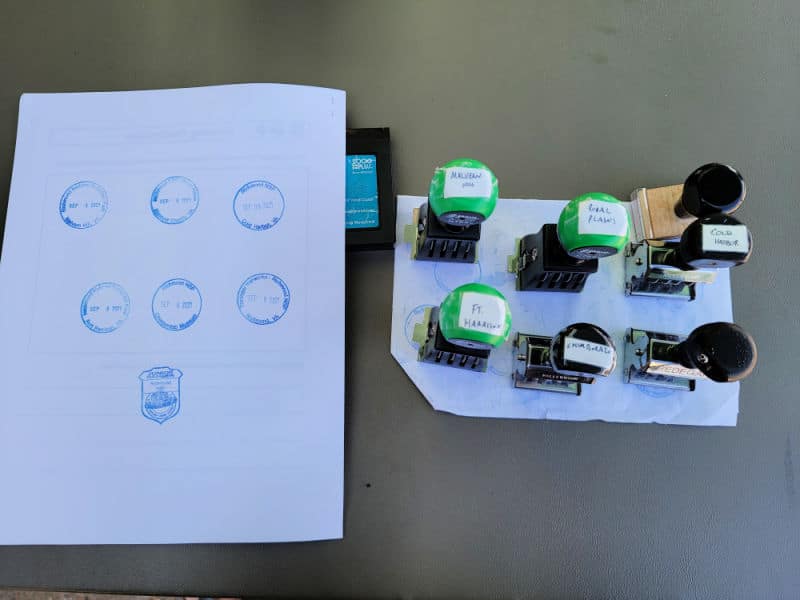
National Park Passport Stamps
National Park Passport stamps can be found in the visitor center.
Richmond NBP is part of the 2009 Passport Stamp Set.
We like to use these circle stickers for park stamps so we don't have to bring our passport book with us on every trip.
The National Park Passport Book program is a great way to document all of the parks you have visitied.
You can get Passport Stickers and Annual Stamp Sets to help enhance your Passport Book.
Electric Vehicle Charging
Technically there are no EV charging stations within the park, but there are dozens of electric vehicle chargers scattered in and around Richmond.
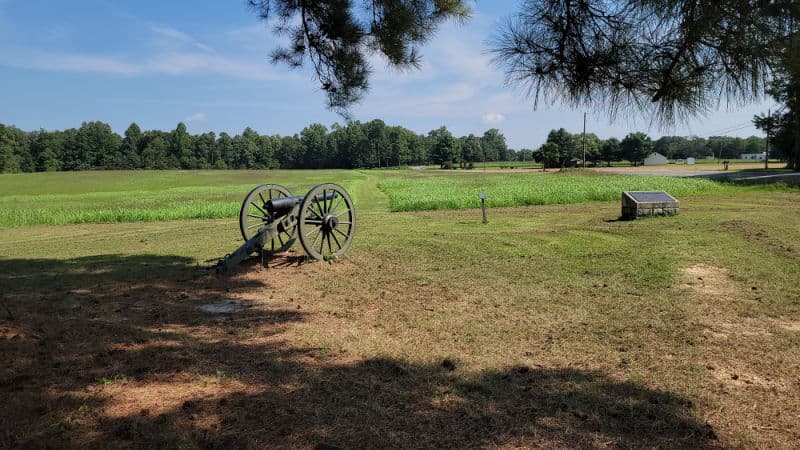
Details about Richmond National Battlefield Park
Size - 8,168.87 acres
Check out how the park compares to other National Parks by Size.
Date Established
March 2, 1936
Visitation
In 2021, Richmond NBP had 152,308 park visitors.
In 2020, Richmond NBP had 179,598 park visitors.
In 2019, Richmond NBP had 197,242 park visitors.
Learn more about the most visited and least visited National Parks in the US
National Park Address
There are 13 park sites within this battlefield park
Beaver Dam Creek Battlefield
7423 Cold Harbor Road
Mechanicsville, VA 23111
Chickahominy Bluff Battlefield
4300 Mechanicsville Turnpike
Richmond, VA 23223
Chimborazo Medical Museum
3215 East Broad Street
Richmond, VA 23223
Cold Harbor Battlefield and Visitor Center
5515 Anderson-Wright Dr.
Mechanicsville, VA 23111
Drewry's Bluff (Fort Darling) Battlefield
7600 Fort Darling Road
Richmond, VA 23237
Fort Harrison Battlefield and Visitor Center
8621 Battlefield Park Road
Richmond, VA 23231
Gaines' Mill Battlefield
6283 Watt House Road
Mechanicsville, VA 23111
Malvern Hill Battlefield
9175 Willis Church Road
Richmond, VA 23231
Park Headquarters
3215 East Broad Street
Richmond, VA 23223
Parker's Battery
1801 Ware Bottom Spring
Chester, VA 23831
Totopotomoy Creek Battlefield at Rural Plains
7273 Studley Road
Mechanicsville, VA 23116
Tredegar Iron Works
500 Tredegar Street
Richmond, VA 23219
National Park Map
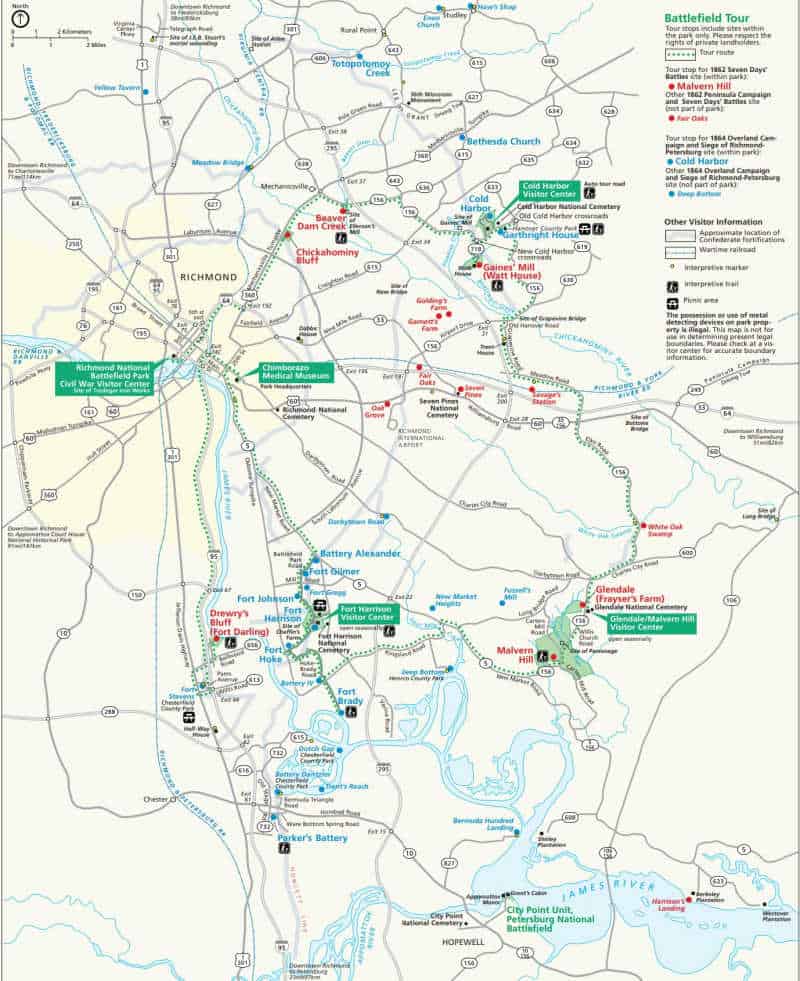
Where is Richmond National Battlefield Park?
Richmond National Battlefield Park is nestled into the center of Virginia, just 100 miles south of Washington DC.
The park’s sites and visitor centers are spread across the city of Richmond and several counties, including Hanover, Henrico, and Chesterfield.
Estimated distance from major cities nearby
Distances calculated from Mechanicsville, VA
- Norfolk, VA - 92 miles
- Virginia Beach, VA - 106 miles
- Washington DC - 112 miles
- Baltimore, MD - 150 miles
- Durham, NC - 162 miles
- Raleigh, NC - 180 miles
- Philadelphia, PA - 248 miles
- Pittsburgh, PA - 330 miles
Estimated Distance from nearby National Park
Shenandoah National Park - 101 miles
New River Gorge National Park - 265 miles
Congaree National Park - 412 miles
Great Smoky Mountains National Park - 417 miles
Mammoth Cave National Park - 623 miles
Where is the National Park Visitor Center?
Cold Harbor Battlefield and Visitor Center
5515 Anderson-Wright Dr.
Mechanicsville, VA 23111
Fort Harrison Battlefield and Visitor Center
8621 Battlefield Park Road
Richmond, VA 23231
Richmond Civil War Visitor Center at the Tredegar Iron Works
500 Tredegar Street
Richmond, VA 23219
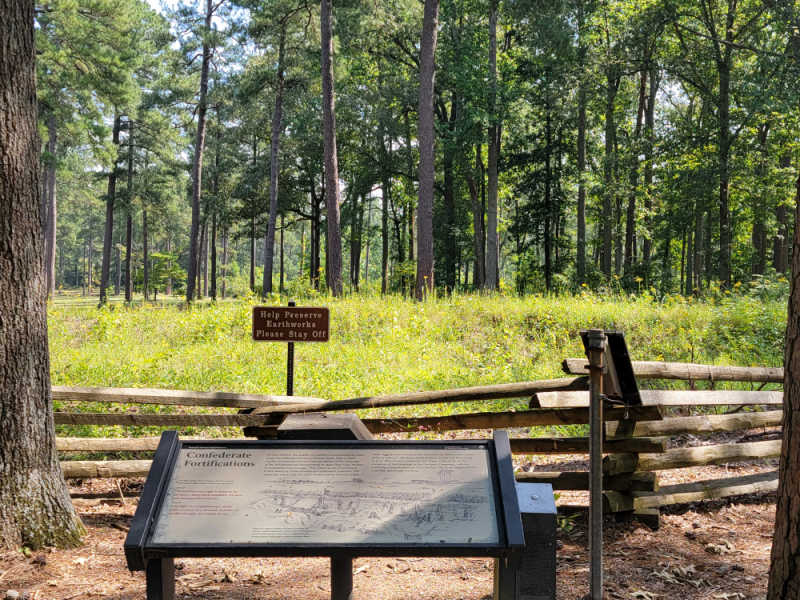
Getting to Richmond National Battlefield Park
Closest Airports
- Newport News/ Williamsburg International Airport (PHF)
- Norfolk International Airport (ORF)
- Charlottesville Albermarle Airport (CHO)
- Ronald Reagan Washington National Airport (DCA)
Driving Directions
Specific driving directions will depend on where you’re coming from and which area of the park you are visiting.
Many choose to start their journey at the Richmond Civil War Visitor Center at the Tredegar Iron Works, located in downtown Richmond off of 5th Street along the Riverfront Canal Walk.
This is a great place to start for a few different reasons. It offers a great overview of the area’s history, battlefields, and the Civil War in general, and it’s also conveniently located off of major routes like VA-195, US-301, and US-60.
Other popular first stops at Richmond National Battlefield Park include the Cold Harbor Battlefield Visitor Center off of I-295 and the Chimborazo Medical Museum off of N 33rd St. in downtown Richmond.
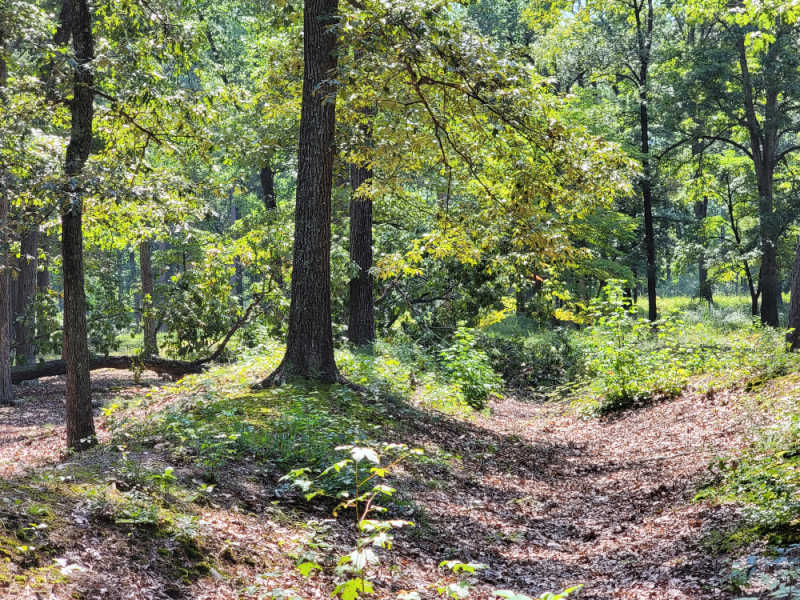
Best time to visit Richmond National Battlefield Park
The best time to visit Richmond National Battlefield Park is between April and June. Temperatures are mild, and the park is much less busy during the spring than during the busy summer months.
Autumn can also see a decrease in visitation, but Richmond and the surrounding area tend to stay busy, with visitors arriving en masse for the vibrant fall foliage.
Weather and Seasons
Spring
Spring is a great time to visit Richmond National Battlefield Park. The area’s weather can be a bit unpredictable, but there’s a good chance that visitors during the spring will experience mild, sunny days.
If you don’t mind taking a chance on the weather, early spring is better than late spring, especially for those who want to avoid large crowds!
Summer
Summer is peak season at Richmond National Battlefield Park. The weather is warm and sunny, and the kids are all on break.
Battlefields, visitor centers, and other units of the park may be a bit busy, so try to avoid weekends and holidays during the summer months.
Fall
Fall is a fabulous time to visit the park. The summer crowds tend to thin out a bit, and the fall foliage is an added perk to visiting at this time of year.
Although the park sees fewer visitors in the fall, Richmond and the surrounding area have their fair share of leaf peepers.
Winter
The park is open year-round, with the exception of a few winter holidays (Thanksgiving, Christmas, and New Year's Day).
Visitation is at its lowest during the colder months, so if you don’t mind the chilly temperatures this is a great time to see the park without all the crowds.
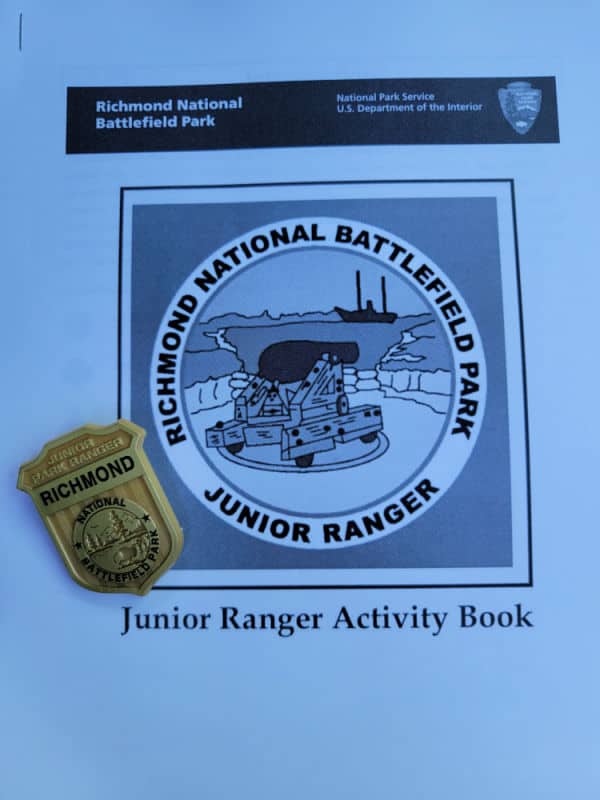
Best Things to do in Richmond National Battlefield Park
There are 13 separate units of Richmond National Battlefield Park in locations all around the Richmond area.
Junior Ranger Program
A BRAND NEW Junior Ranger booklet can be found here!
The Seven Days' Expedition Packet can be completed in addition to the Junior Ranger booklet. CLICK HERE to download
The Junior Ranger Program is an excellent way to learn more about the park, whether you’re young or young at heart. The program allows you to explore the area in a hands-on way and learn about the complex history of Richmond National Battlefield Park.
Cold Harbor Battlefield and Visitor Center
Cold Harbor Battlefield is one of the most famous battlefields in the entire park. It was here that the armies led by Robert E. Lee and Ulysses S. Grant came head to head in a series of complicated maneuvers.
The stalemate lasted about two weeks but eventually ended with Grant deciding to move south and advance on Petersburg.
This battlefield also has an excellent visitor center, complete with an electric map of the area, exhibits, and a small bookstore. There is also a short drive and a few walking trails that allow visitors to see some wartime entrenchments.
Chimborazo Medical Museum
Chimborazo was one of the largest military hospitals of the Civil War, with over 100 different wards, a bakery, and even a brewery!
Unfortunately, the hospital no longer exists, but the Chimborazo Medical Museum does a great job of illustrating what this impressive building was like.
There are original medical instruments and personal artifacts, along with a model scale of the hospital and a short film depicting life at the hospital.
Fort Harrison Battlefield and Visitor Center
Fort Harrison and the area that surrounds it played an important role during the Civil War.
Union troops captured the fort in September 1864 and built more fortifications nearby over the course of six months.
The Fort Harrison area features the original walls of some of these fortifications, along with exhibits to describe certain events that occurred here. There are also a few walking and biking trails in the area, along with a small visitor center open seasonally.
Tredegar Iron Works
Wars require a large stock of artillery, ammunition and other heavy-duty materials.
The Tredegar Iron Works produced materials for the Confederacy, and while the original building is long gone, the contact station here tells the story of the Iron Works.
Inside you’ll find maps, information about other park sites, and an orientation film.
From there, you can walk to the James River and Kanawha Canal, or visit Brown’s Island and Belle Isle.
The former was used as a site where women and children produced ammunition for the war, and the latter was used as a prisoner-of-war camp for thousands of Union troops.
Beaver Dam Creek Battlefield
This area of the park preserves about two miles of riverfront that Confederates unsuccessfully attacked.
Nonetheless, it was a bold attack, and Union troops were forced to retreat to the high ground near Gaine’s Mill. There is a short trail near the parking area with exhibits to describe the battle.
Chickahominy Bluff Battlefield
Chickahominy Bluff was the starting place for the Seven Days Campaign. It was on this bluff that over 20,000 Confederate troops awaited the signal from Robert E. Lee to advance across the Chickahominy River and begin the offensive east of Richmond.
Today, visitors can listen to an audio exhibit atop the overlook platform and look for the remains of earthworks created to defend the Confederate army.
Drewry's Bluff (Fort Darling) Battlefield
Fort Drewry (known as Fort Darling to Union troops) helped the Confederates defend the city of Richmond by blocking the progress of the U.S. Navy along the James River.
Fort Drewry saw a decisive battle on May 15, 1962, which permanently ended the attempt of the Navy to infiltrate the city via the James River.
Today, much of the fort remains intact, and there is a walking trail, numerous exhibits, and a viewing platform above the river.
Gaines' Mill Battlefield
Gaines’ Mill Battlefield was home to one of the bloodiest battles of the Seven Days Campaign. Over 15,000 troops were killed, wounded, or captured, and the Confederacy made strides to push back the Union’s position.
The Union headquarters (the Watt House) still stands, and there is also a walking trail with historical markers and monuments along the way.
Malvern Hill Battlefield
Malvern Hill is one of the most well-preserved battlefields in the Richmond area and features an extensive walking trail with an audio podcast available depicting the events at this battlefield back in 1862.
On July 1, a large portion of the Confederate army made attacks along the slope of Malvern Hill but failed to contend with the strong Union defense.
This marked an end to the Seven Days Campaign and a big win for the Union.
Parker's Battery
Parker's Battery sits between Richmond and Petersburg and makes up part of the Confederate’s “Howlett Line”.
This line was defended by an artillery company and stood for nearly a year between 1864 and 1865.
Today, there is a short walking trail that features original fortifications and a monument commemorating members of the company from Richmond.
Totopotomoy Creek Battlefield at Rural Plains
Although this area saw its fair share of battles during the Civil War, the Totopotomoy Creek Battlefield at Rural Plains also depicts the history that precedes the war.
The Shelton House stands tall and dates back to 1723. The home was owned by the Shelton family for nearly 300 years before it was sold to the National Park in 2001.
Today, you can learn more about the house, its historical importance, and some Civil War history at the Totoptomy Creek Battlefield.
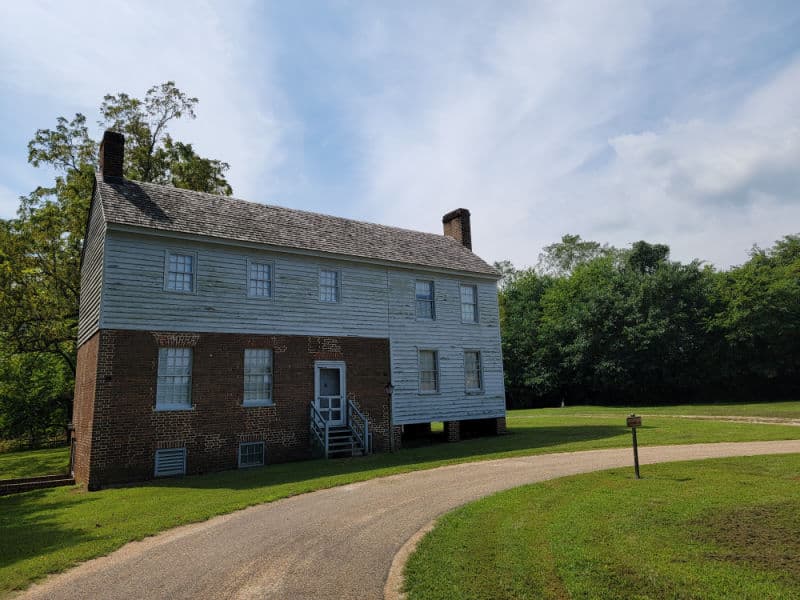
Hiking in Richmond National Battlefield Park
Always carry the 10 essentials for outdoor survival when exploring.
While Richmond National Battlefield Park is more geared towards history than scenic mountain hikes, there are a few great trails within the park.
Most combine serene natural settings and historic Civil War sites, so you can get the best of both worlds as you explore the park via its trails.
Gaines’ Mill Trail
- Distance - 1.33 miles
- Trail Difficulty - Easy
- Time Required - 30 minutes
- Trailhead - Gaine’s Mill Battlefield
Gaines’ Mill battlefield features two interconnected loops that wind through the historic hardwood forest above Boatswain Creek.
The main walking trail (and first loop) leads along the Union line. This area is where the confederates drove a wedge through the army and the first crack in the Union began.
The second loop wanders further into Union territory and features a monument to Alabama troops. The last .15 miles is a spur trail that offers a scenic overlook across the valley of the Chickahominy River.
Totopotomy Creek Trail
- Distance - 1.36 miles
- Trail Difficulty - Easy
- Time Required - 30 minutes
- Trailhead - Totopotomoy Creek Battlefield at Rural Plains
Totopotomy Creek Trail leads through the fields and gardens that surround the Shelton House.
There are a couple of pieces of Union-built entrenchments that have survived, along with a family cemetery out front.
The last part of the trail leads through some stunning forest scenery to a footbridge overlooking Totopotomoy Creek and its surrounding wetlands.
From there, you can cross the bridge and examine the southern slope, where Confederate soldiers once stood sentinel.
Cold Harbor Battlefield Trail
- Distance - 3.4 miles
- Trail Difficulty - Easy
- Time Required - 1 hour
- Trailhead - Cold Harbor Battlefield
The Cold Harbor Battlefield Trail consists of three connecting loops. These trails are lined with large forests, Bloody Run Creek, and plenty of Civil War history.
All three loops run through critical battleground land and feature original fortifications, monuments, and signage depicting the importance of the area.
Malvern Hill Battlefield Trail
- Distance - 2.9 miles
- Trail Difficulty - Moderate
- Time Required - 1 hour
- Trailhead - Malvern Hill Battlefield
The Malvern Hill Battlefield Trail allows hikers to follow in the footsteps of soldiers of the Civil War - both Union and Confederates.
The trail leads to all four corners of the battlefield and follows the route of a Confederate attack, the Union cannon line, and other areas of historic relevance.
Even if you’re not a history buff, this trail is great for getting the blood pumping, and it also offers excellent opportunities for birding and wildlife watching thanks to the diverse habitats that line the route.
Other trails at Richmond National Battlefield Park include Drewry's Bluff, Fort Brady, Parker's Battery, and Fort Harrison.
These are all short (under one mile) trails, and some are paved and wheelchair accessible.
How to beat the crowds in Richmond National Battlefield Park?
We did not experience any crowds while visiting the park.
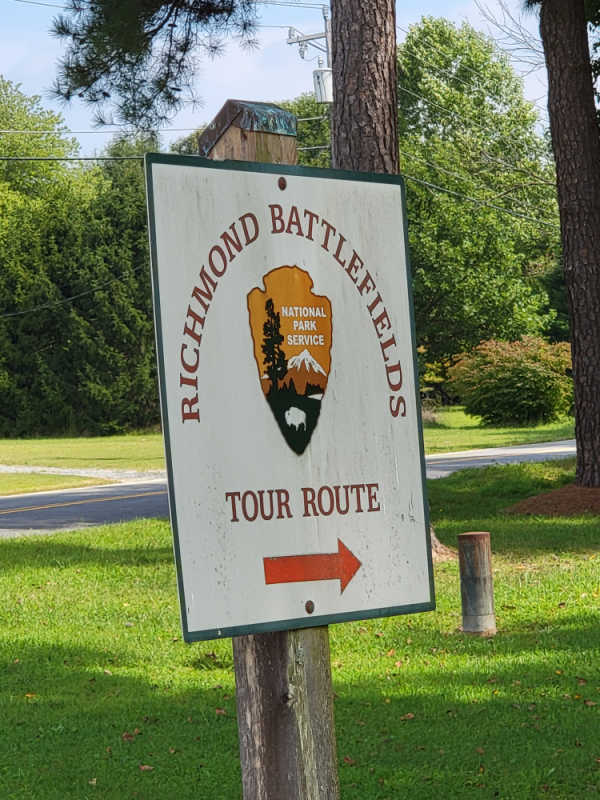
Where to stay when visiting Richmond National Battlefield Park
There are no National Park Lodges within the park.
Nearby lodging can be found in Richmond, Virginia and surrounding area.
Hampton Inn Richmond - South - A free breakfast buffet, dry cleaning/laundry services, and a 24-hour gym are just a few of the amenities provided at Hampton Inn Richmond - South. Free in-room Wi-Fi is available to all guests, along with a 24-hour business center and a snack bar/deli.
Courtyard by Marriott Richmond Airport - Consider a stay at Courtyard by Marriott Richmond Airport and take advantage of a free roundtrip airport shuttle, a firepit, and a coffee shop/café. The onsite bistro, The Bistro, features American cuisine. In addition to dry cleaning/laundry services and an outdoor entertainment area, guests can connect to free in-room Wi-Fi.
Hyatt Place Richmond/Chester - You can look forward to free full breakfast, a coffee shop/café, and laundry facilities at Hyatt Place Richmond/Chester. Be sure to enjoy a meal at Gallery, the onsite restaurant. Free in-room Wi-Fi is available to all guests, along with a bar and a 24-hour gym.
Berkeley Hotel - 4-star hotel in the heart of Downtown Richmond. At The Berkeley Hotel, you can look forward to a terrace, a gym, and a 24-hour business center. Stay connected with free in-room Wi-Fi.
Hyatt Place Richmond Airport - At Hyatt Place Richmond Airport, you can look forward to a free breakfast buffet, a free roundtrip airport shuttle, and golfing on site. Stay connected with free Wi-Fi in public areas, and guests can find other amenities such as a grocery/convenience store and a shopping mall on site.
Click on the map below for additional vacation rental and lodging options near the park.
Camping
There are no National Park Campground within the park.

For a fun adventure check out Escape Campervans. These campervans have built in beds, kitchen area with refrigerators, and more. You can have them fully set up with kitchen supplies, bedding, and other fun extras. They are painted with epic designs you can't miss!
Escape Campervans has offices in Vancouver, Seattle, Portland, San Francisco, Las Vegas, Los Angeles, Phoenix, Salt Lake City, Denver, New York, and Orlando
Richmond Guided Tours
Ghosts and Dark History Haunted Walking Tour - Explore the haunted side of the Shockoe Bottom area of Richmond on a walking tour with a local guide and visit some of the most historic and haunted locations around the city.
Hollywood Cemetery Guided Walking Tour - Hear the tales behind Richmond’s most notable gravesites on a guided tour of Hollywood Cemetery. See graves of presidents, enjoy views of the James River, and learn little-known tales about Richmond. Travel back in time to the Civil War and hear tragic and heartwarming stories
Private City Tour by Tuk Tuk - Discover Richmond on a private guided tour. Make your way around the city in a Tuk Tuk and see the highlights of Virginia’s capital, including Monument Avenue, Hollywood Cemetery, and more.
Guided Hike in James River Park - Explore the hidden gems in the heart of downtown Richmond. Discover 150-year-old ruins, see the unique Pipeline Walk, and revel in the roaring rapids on this guided hiking tour of James River Park.
Church Hill Scavenger Hunt - Embark on a scavenger hunt of Richmond by solving riddles and clues. Discover the countless stories of heroism, historical figures real or imagined, and hidden nooks in the city's oldest neighborhood.
Capitol Hill Ghost Walking Tour with Guide - Climb Richmond's Capitol Hill on a walking tour to see that it's not just elected officials and security guards who patrol the hallowed halls of Virginia's legislative and executive seat of power.
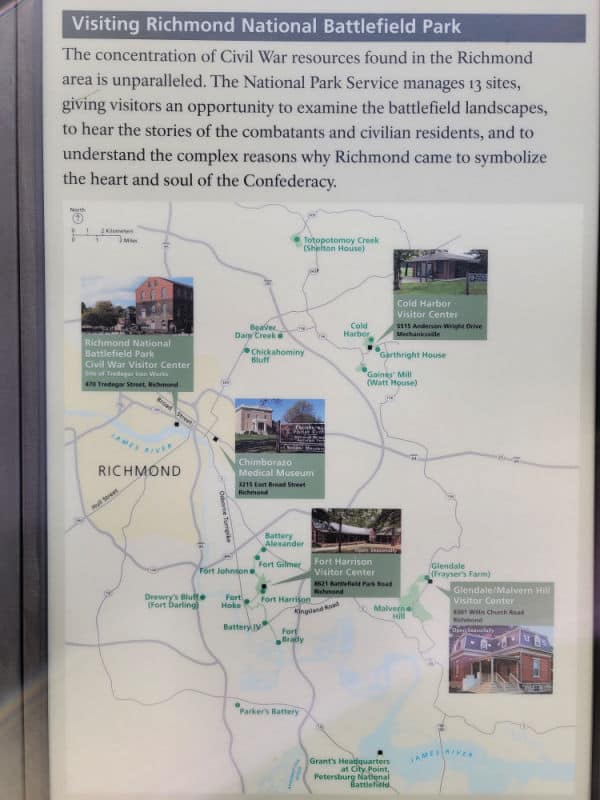
Parks Near Richmond National Battlefield Park
Petersburg National Battlefield
Colonial National Historical Park
Fredericksburg & Spotsylvania National Military Park
Booker T Washington National Monument
Blue Ridge Parkway
Appalachian National Scenic Trail
Check out all of the Virginia National Parks along with neighboring National Parks in West Virginia, National Parks in Tennessee, North Carolina National Parks, Maryland National Parks, and Kentucky National Parks
Make sure to follow Park Ranger John on Facebook, Instagram, Pinterest, and TikTok





Leave a Reply